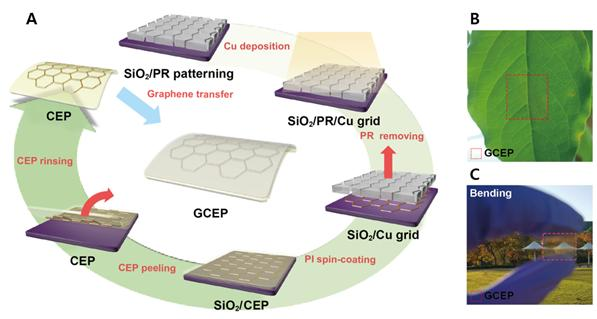Jul 6 2020
A research team, affiliated with Ulsan National Institute of Science and Technology (UNIST), has developed an innovative electrode that is expected to considerably enhance the stability of perovskite solar cells (PSCs).
 Electrode platform consisting of CEP film and a GCEP. (a) The GCEP fabrication process and (b and c) digital images of GCEP. Image Credit: Ulsan National Institute of Science and Technology.
Electrode platform consisting of CEP film and a GCEP. (a) The GCEP fabrication process and (b and c) digital images of GCEP. Image Credit: Ulsan National Institute of Science and Technology.
PSCs are the most potential candidates for state-of-the-art solar cells because they are cost-effective and also have excellent power conversion efficiency.
This is because when a protection layer is embedded between the perovskite film and the metal-based electrode, it can inhibit the degradation caused by metals and allow graphene, as such a layer, to effectively prevent the diffusion of halide ions and metals.
This innovation was headed by Professor Hyesung Park and his team of researchers in the School of Energy and Chemical Engineering based at UNIST.
In their study, the researchers created a flexible metal grid-based hybrid electrode platform by employing a graphene sheet as the protection layer, called GCEP, and a Cu grid-embedded polyimide (CEP) film. The GCEP has mechanical durability, exceptional chemical stability, and high electrical conductivity.
Using this setup, the researchers showed how graphene crucially serves as a protection layer to inhibit the degradation caused by metals and the diffusion of halide ions between the perovskite layer and electrode.
While metal oxide-based electrodes (ITOs) have been employed as traditional transparent conducting electrodes, they are so inflexible that they can be easily fractured or broken; therefore, they are not suitable for wearable device applications.
Specifically, the degradation caused by the interdiffusion of halide ions and metals between the perovskite layer and the metal electrode mainly inhibits the use of metal-based transparent conductive electrodes (TCE) in PSCs.
To solve this problem, the scientists inserted a graphene sheet to serve as the protection layer at the interface of the perovskite layer and the metal electrode. Graphene has excellent electrical conductivity, and as a result, electrons can travel easily through it. But graphene also has exceptional impermeability, which means it inhibits the permeation of even the tiniest molecule.
Graphene can be an effective diffusion barrier if combined with metallic nanostructures having the following characteristics: outstanding impermeability to metal and halide ion diffusion at the metal electrode/perovskite layer interface, enhanced charge collection across the void spacings of the metal nanostructures, minimal loss of optical transmittance as a protection layer due to its high optical transparency, and improvement of the mechanical durability of the hybrid electrode.
Researchers, Ulsan National Institute of Science and Technology
Using this flexible and transparent hybrid electrode, the scientists developed flexible metal TCE-based PSCs, achieving excellent mechanical and chemical stability. Similar to that of its ITO-based rigid counterpart that achieves a PCE of 17.5%, the newly developed device was able to achieve a high PCE of 16.4%.
By preventing the interdiffusion of the metals and halide ions, the researchers also validated the role of the graphene layer with regard to guaranteeing the chemical stability of solar cells
The GCEP electrode also enhanced the photostability of the PSC by blocking the near-UV and ultraviolet (UV) light. In addition, the electrode maintained an initial efficiency of more than 97.5% even after 1000 hours. Moreover, after 5000 bending tests, it displayed exceptional mechanical durability, like maintaining the initial efficiency of 94%, thus making it relevant for advanced wearable devices.
This paper demonstrates that inserting a protection layer between the metal-based electrode and the perovskite film could prevent metal-induced degradation and that graphene, as such a layer, can effectively suppress the diffusion of metals and halide ions.
Gyujeong Jeong, Combined MS/PhD Program of Energy and Chemical Engineering, Ulsan National Institute of Science and Technology
Jeong is the first author of the study.
“The new method has significantly improved both the efficiency and stability of PSCs,” added Professor Park. “This work provides an effective strategy to design mechanically and chemically robust ITO-free metal-assisted TCE platforms in PSCs.”
The study findings were published in the online issue of Nano Letters on May 13th, 2020. The study was funded by the Basic Science Research Program via the National Research Foundation of Korea (NRF) financially supported by the Ministry of Science and ICT (MSIT). The 2019 Research Fund of KOREA East-West Power Co., LTD (EWP) has also supported the study.
Journal Reference:
Jeong, G., et al. (2020) Suppressed Interdiffusion and Degradation in Flexible and Transparent Metal Electrode-Based Perovskite Solar Cells with a Graphene Interlayer. Nano Letters. doi.org/10.1021/acs.nanolett.0c00663.